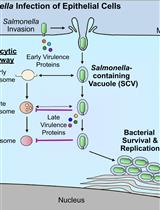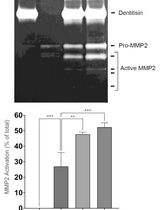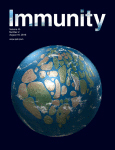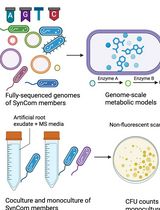- EN - English
- CN - 中文
Escherichia coli Infection of Drosophila
果蝇的大肠埃希杆菌感染
发布: 2017年05月05日第7卷第9期 DOI: 10.21769/BioProtoc.2256 浏览次数: 9096
评审: Ruth A. FranklinModesto Redrejo-RodriguezFilipa Vaz

相关实验方案

细菌病原体介导的宿主向溶酶体运输的抑制:基于荧光显微镜的DQ-Red BSA分析
Mădălina Mocăniță [...] Vanessa M. D'Costa
2024年03月05日 2443 阅读

通过制备连续聚丙烯酰胺凝胶电泳和凝胶酶谱分析法纯化来自梭状龋齿螺旋体的天然Dentilisin复合物及其功能分析
Pachiyappan Kamarajan [...] Yvonne L. Kapila
2024年04月05日 1655 阅读
Abstract
Following septic insults, healthy insects, just like vertebrates, mount a complex immune response to contain and destroy pathogens. The failure to efficiently clear bacterial infections in immuno-compromised fly mutants leads to higher mortality rates which provide a powerful indicator for genes with important roles in innate immunity. The following protocol is designed to reproducibly inject a known amount of non-pathogenic E. coli into otherwise sterile flies and to measure the survival of flies after infection. The protocol can be easily adapted to different types of bacteria.
Keywords: Drosophila (果蝇)Background
Classic infection experiments involve infecting Drosophila orally (Chakrabarti et al., 2016) or with a needle dipped in a concentrated bacterial solution (Romeo and Lemaitre, 2008). Unlike these protocols, our experimental procedure allows us to determine the site of infection and precisely control the dose of bacteria injected into each fly. This provides homogeneity and reproducibility, and allows us to adapt bacterial load for different experiments (Akbar et al., 2011 and 2016).
Materials and Reagents
- 15 ml Falcon tubes (Corning, catalog number: 352196 )
- 1.5 ml Eppendorf tubes (USA Scientific, catalog number: 1615-5500 )
- Kimwipes
- 26 G needle (BD, catalog number: 305111 )
- Spin columns (e.g., Thermo Fisher Scientific, Thermo ScientificTM, catalog number: 69700 )
- Empty and clean Drosophila vials (Genesee Scientific, catalog number: 32-109 )
- Microloader tips (Eppendorf, catalog number: 930001007 )
- Vials (Genesee Scientific, catalog number: 32-109 ) with standard Drosophila food (lightly yeasted)
- Microslide (Corning, catalog number: 2948-75X25 )
- 50 Drosophila melanogaster adult virgins (Romeo and Lemaitre, 2008), aged five to seven days post eclosion (see Note 1)
- E. coli-DH5α containing any ampicillin-resistant plasmid (e.g., expressing GFP)
- pEGFP (https://www.addgene.org/vector-database/2485/)
- pET-GFP-C11 (http://www.addgene.org/30183/)
- LB broth (Fisher Scientific, catalog number: BP1426-500 )
- Ampicillin (200 mg/ml) (Sigma-Aldrich, catalog number: A9518 )
- 70% ethanol–diluted from 100% ethanol (Pharmco-AAPER, catalog number: 111000200 )
- Mineral oil (Fisher Scientific, catalog number: O121-1 )
- Sodium chloride (NaCl) (Fisher Scientific, catalog number: S271 )
- Potassium chloride (KCl) (Sigma-Aldrich, catalog number: P9541 )
- Sodium phosphate dibasic heptahydrate (Na2HPO4·7H2O) (Sigma-Aldrich, catalog number: S9390 )
- Potassium phosphate monobasic (KH2PO4) (Fisher Scientific, catalog number: S397-500 )
- 1x PBS (see Recipes)
Equipment
- 37 °C incubator with shaking (Eppendorf, New BrunswickTM, model: Innova® 44 )
- Spectrophotometer (Molecular Devices, model: SpectraMax M2 )
- Borosilicate glass capillaries (WPI, catalog number: TW100-4 )
- Centrifuge capable of spinning Falcon tubes (Eppendorf, model: 5804 R )
- Flaming/Brown Micropipette puller (Sutter Instrument, model: P-97 )
- Mini benchtop centrifuge (Fisher Scientific, model: FisherbrandTM Standard Mini Centrifuge , catalog number: 05-090-100)
- Pico-Injector (Nikon Instruments, catalog number: PLI-188 )–requires nitrogen gas
Note: Should have foot pedal for injecting. - 25 °C incubator (BioCold Environment, model: BC49-IN )
- Anesthetizing fly pad (Genesee Scientific, catalog number: 59-119 )
- Small brush
- Dissecting microscope (Leica)
Software
- Prism (GraphPad) software
Procedure
文章信息
版权信息
© 2017 The Authors; exclusive licensee Bio-protocol LLC.
如何引用
Tracy, C. and Krämer, H. (2017). Escherichia coli Infection of Drosophila. Bio-protocol 7(9): e2256. DOI: 10.21769/BioProtoc.2256.
分类
免疫学 > 动物模型 > 果蝇
微生物学 > 体内实验模型 > 细菌
微生物学 > 微生物-宿主相互作用 > 细菌
您对这篇实验方法有问题吗?
在此处发布您的问题,我们将邀请本文作者来回答。同时,我们会将您的问题发布到Bio-protocol Exchange,以便寻求社区成员的帮助。
提问指南
+ 问题描述
写下详细的问题描述,包括所有有助于他人回答您问题的信息(例如实验过程、条件和相关图像等)。
Share
Bluesky
X
Copy link










